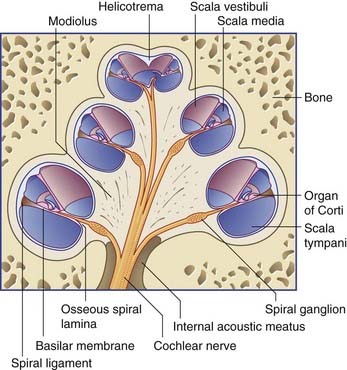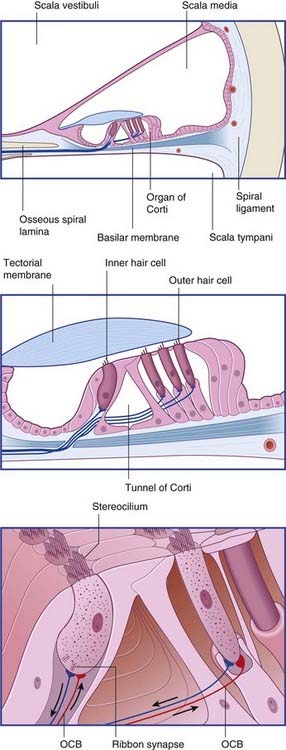20 Cochlear nerve
Auditory System
The cochlea
The main features of cochlear structure are seen in Figures 20.1 and 20.2. The cochlea is pictured as though it were upright, but in life it lies on its side, as shown earlier in Figure 19.1. The central bony pillar of the cochlea (the modiolus) is in the axis of the internal acoustic meatus. Projecting from the modiolus, like the flange of a screw, is the osseous spiral lamina. The basilar membrane is attached to the tip of this lamina; it reaches across the cavity of the bony cochlea to become attached to the spiral ligament on the outer wall. The osseous spiral lamina and spiral ligament become progressively smaller as one ascends the two and one half turns of the cochlea, and the fibers of the basilar membrane become progressively longer.
The outer hair cells are contractile (in tissue culture), and they have substantial efferent nerve endings (Figure 20.2). In theory, at least, oscillatory movements of outer hair cells could influence the sensitivity of the inner hair cells through effects on the tectorial or basilar membrane.
Sound transduction
The vibrations of the tympanic membrane in response to sound waves are transmitted along the ossicular chain. The footplate of the stapes fits snugly into the oval window, and vibrations of the stapes are converted to pressure waves in the scala vestibuli. The pressure waves are transmitted through the vestibular membrane to reach the basilar membrane. High-frequency pressure waves, created by high-pitched sounds, cause the short fibers of the basilar membrane in the basal turn of the cochlea to resonate and absorb their energy. Low-frequency waves produce resonance in the apical turn where the fibers are longest. The basilar membrane is therefore tonotopic in its fiber sequence. Not surprisingly, the inner hair cells have a similar tonotopic sequence. In response to local resonance, the cells become depolarized and liberate excitatory transmitter substance from synaptic ribbons (Figure 20.2).











